Start with the IMDB information: 1 hour and 23 minutes, with a score of 2.4/10 from 761 brave souls.
It is also a fact that it has two dates. The core was filmed in 1967. Notice the bouffant hairstyles and the hairspray required to hold them in place. The film, however, was not released until 1972 when a creative entrepreneur bought it, and proceeded to cut and paste into and around the core excerpts from two other, as yet unidentified movies, to produce this pastiche. Ordinarily such comments about production follow a discussion of the film but in this case they offer an explanation for the mish-mash.
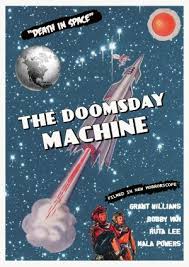
Let’s try to take it in turn. It opens with a woman sneaking into a secret (but poorly guarded facility) and since everyone looks California Chinese we are to conclude it is RED CHINA! This woman is a spy and she proceeds to murder the hapless security guard. Evidently the budget cutters had been at it and reduced the security to this schmo. She also — and the fraternity brothers liked this touch — strangles a lab technician with her own pigtails. She also stabs another lab rat who happens along. With her blood lust sated, she then examines a throbbing mechanism. Imagine what the fraternity brothers made of that.
Next she is seen behind a slide carousel (that’s a memory test) projecting pictures of the aforementioned mechanism to a room full of hirsute men with yacht sails for neckties, saying only Chairman Mao has the key for it. Heavy! They conclude it is a Doomsday Machine and pick up the phone to call the president in Florida on the golf course.
This is part one and it is lifted from another film entirely and we never see any of these characters again, but it justifies the title that was put on in 1972. It is all poorly staged, acted, lit, photographed, and very unbelievable. Not even the Twit-in-Chief would fall for it. Hmm.
Now we come to the core which has an airforce mission to Venus in preparation. NASA is nowhere to be seen but there are many blue uniforms and much saluting. There are seven men, straight and tall, ready to go. Much banter among them. Much stress on the physical rigours that await them, and their superb preparation. More saluting.
Then a car pulls up, security here, too, is lax, because a civilian emerges. Suits are always bad news among uniforms and this suit has three women in tow, but at least they are each in uniform. Gasp! One of them is in a brown uniform with a Red Star on it! Gasp. A Russky! Gasp! [It goes on like this for a while.]
By order of the Twit-in-Chief, three of the men are stood down and the three women replace them. Much amazement among the men that a woman might be a flight surgeon, a space pilot though this patricianly specimen was the first woman on the Moon, and an astrophysicist. Uniforms, military rank, a bushel of advanced degrees these they may have but they are WOMEN!
However ‘ein Befehl ist ein Befel’ and Colonel Physique submits, though he asks repeatedly why, especially as to the Red Russky. The long established plan is abrogated and they are launched toute suite, without a lot of TSA pre-flight checks. Again there is no explanation for the rush, but viewers know it must have something to do with Chairman Mao.
In sum, we have three young men and the old codger along with three nubile young women with bouffants. The fraternity brother had no trouble following this.
Sure enough the codger goes crook, and the women look after him, when not serving drinks. Colonel Physique strips off his shirt, and on him and this more below to reward the persevering reader, and parades around bumping into the women in states of undress. ‘This is ridiculous!’ he shouts. So did we. The visual evidence confirms three young men and three young women.
Pairing begins immediately when one unstable, snivelling male, let’s call him Donald, jumps on one of the women. So this the elite of the best of the best. His approach reminded the fraternity brothers of things they had seen in the zoo. The object tries to put him off, short of belting him. ‘No’ is not the answer Donald wants, and we all knew ‘he’ll be back.’
Meanwhile, they lose contact with ground control, because…. there is no longer any ground. Turns out the China Syndrome was right. Bored one night, Mao turned the key on the throbber and it split the world apart. Gasp! They watch the CNN broadcast of the end of the world, but give it a stingy two stars. Bang. No more Earth. Ah ha, that is why the women are on board. The United States Air Force has sent Adams and Eves in space with that codger as chaperone, though why a Russky was included still baffles Physique.
As usual, a meteor has crippled the ship and radiation is bad so they apply much Reynolds Wrap Heavy Duty here and there to fix it up. But they have used too much fuel outrunning the debris that once was Earth and dodging the meteors. Meanwhile, Donald continues to harass the object of his extension. In fact, and this is a first for the Sy Fy seen thus far he tries to rape her, in an airlock.
Remember how lax the security has been everywhere? Ditto for airlocks. There is a big red button with a sign in 8-point type that says Do Not Push. In their struggle it gets pushed and the load is lightened by two as they are blown out into space. Donald, OK, but her, she was the victim. There is no justice in space.
Still the load is too heavy to reach Venus. Whoa. Almost forgot Venus, and so did the director and producer. They talk about throwing each other out to lighten the load.
‘Why didn’t they use the hairspray aerosols for propulsion?’ cried a fraternity brother. ‘Why not ditch the codger? asked another. A third, suggested that they jettison the hairspray tins and the brushes, combs, and other impedimentia seen earlier. In fact, he suggested they ditch their clothes. These boys are smart despite their grades.
In the meantime one crewman and the Russky in space suits clamber outside the ship to repair a tear in the Reynolds Wrap and accidentally on purpose the rocket zooms out from under them and the are lost in space floating. They make comic relief remarks.
But by chance, in the vastness of space, there floats by a Russky spaceship. Is that handy or what! They board… Wait.
Here is where another, third film is cut and pasted in showing two completely different people in different space suits entering a ghost space ship where they find the crew dead but the ship fully operational, though it is the comic relief man who pilots it, the Russky ship, and not the Russky woman pilot with him. No women drivers in space. Note for pedants. These space suits are not those originally made for ‘Destination Moon’ (1951) and used repeatedly in other films since that year. Either they were worn out when this clanger was made or they were checked out to an Apollo mission.
They radio the mother ship [get it] and there is much talk of heading on….
Cut back to Adam and Eve, oh and the codger is still looking on and moving his lips about the future. An eternal optimist.
At this point a title card came up: The End.
Word on the inter-web is that the producers of the original film about the Venus mission went bankrupt before filming the Venus part and that is why it went on the shelf in 1967. The new producer spliced in other stuff and added a voice over ending with the codger rabbiting on about little rabbits or something to sell the resultant turkey to the drive-in market.
Roger Corman also spliced in various visuals of the destruction of the Earth from public domain news footages of fires, floods, GOP majorities, and other disasters, passing space junk, including two or three ersatz space stations cribbed from other movies and which were never noticed by the crew, and many different rockets. The ship they set out on morphed into two later configurations. Ditto the space suits as noted above.
The comic relief by the way was played by that triple threat performer Bobby Van, cannot sing, cannot dance, and cannot act. Confirmed. Confirmed. Confirmed.
Physique is played by Denny (Scott) Miller, a Hosier. whose stint as the title character in ‘Tarzan, the Ape Man’ (1959) left him forever shirtless. His parents were physical education nuts and passed it on to him. He went into television and had a long career as an extra, often unnamed. I recognised him from something but could not identify it, though he was recurrent on ‘Wagon Train’ (1961-1964). Although his real claim to fame is that he played basketball at UCLA. Most Hoosiers are born with cross-over dribble in the blood.
His Eve was Ruta Lee neé Ruta Kilmonis from Quebec, who likewise had a long subsequent career on day-time televisions soap operas up to and including 2017.
Mike Farrell has a few early lines as a journalist, before he went to Korea.
Month: November 2017
‘The Amazing Transparent Man’ (1960)
After completing the Invisible WoMan spin offs, this seemed the next logical title. It was all the more intriguing for being directed by Edgar Ulmer whose ‘The Man from Planet X’ (1951) and ‘Beyond the Time Barrier’ (1960) had merits and his ‘Detour’ (1945) has many rave reviews. That was enough for me to tune in.
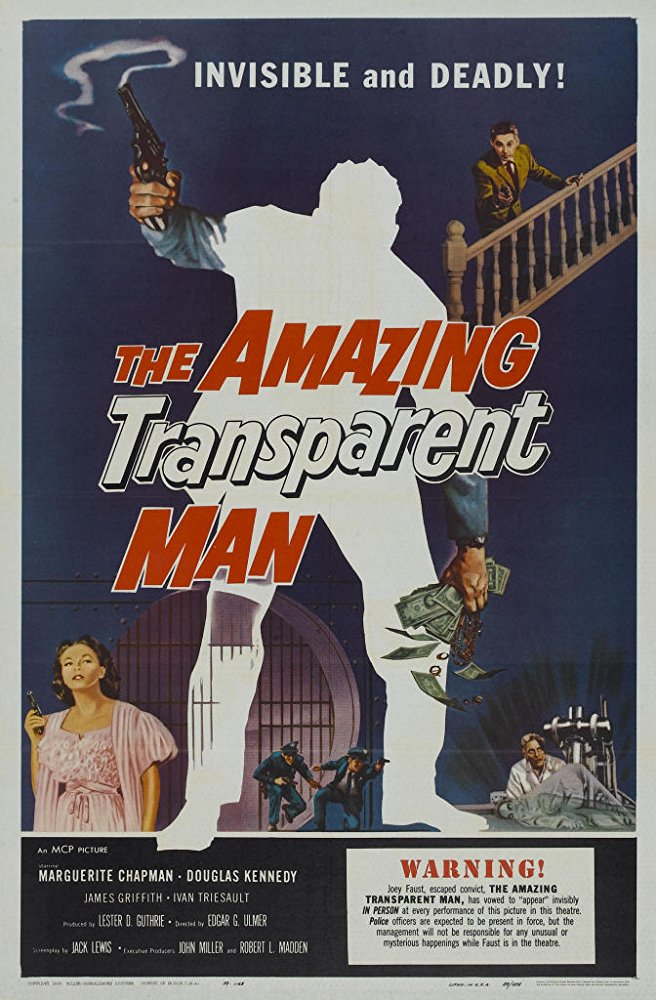
It starts with a boring jailbreak where the villain climbs a wall and hops into a hot convertible driven by a moll. In the dark he sheds his prison stripes for civies and in a moving car without the aid of mirror he ties a bow tie! Wow! This is a man to watch, as long as possible.
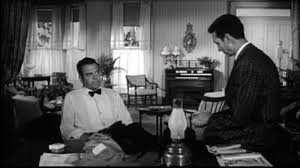 Note the bow tie.
Note the bow tie.
I knew then why his name was Joe Faust. He had already sold his soul to the devil if he could do that.
The convertible was driven by B-picture stalwart Marguerite Chapman, who topped the bill in ‘Flight to Mars’ (1951). Her childhood nickname was Slugger and it seems she lived up to that name in later life as a few wanna be Lotharios discovered. Now if she had just knocked some sense into this screenwriter.
James Griffith, familiar from 1950s television, wants Faust to steal radium for experiments he is running with a coerced German scientist whose daughter he is holding captive. Faust was in the slammer as an ace number-one bank robber, and so knows a thing or two about vaults, entering and exiting there from.
So far, so what, but…Griffith wants radium for transparency experiments. The word ‘invisible’ was never used, and I listened for it, as I am sure the lawyers for the Universal franchise did too. His German scientist, who gives the only creditable performance, can render living beings transparent for brief periods but he needs more radium to perfect the process and extend the time. Of course with prolonged exposure one becomes dead and buried, beyond transparency.
Faust talks tough but agrees quickly. Faust by the way is a behemoth and why he did not just muscle his way out then or later passes belief. Griffith is no match for him on any score and his one measly henchman sleeps most of the time. It is so hard to get good henchmen in B movies.
Faust steals some radium and has fun assaulting unsuspecting people in his transparent state. Since funds are needed he decides to do likewise in a bank where a wad of cash is conveniently bagged on a table top. Off he…, whoops, the transparency juice wears off and he passes into and then out and then back into whole and part visibility. The effects are good but very brief and not well centred.
Marguerite and Faust plot against Griffith and in the resulting showdown the radium is ignited. Kaboom. End.
Earlier the daughter was freed, and she had a non-speaking part and stuck to her amazing silence, and the scientist was liberated. These two survive and he offers the last line asking the audience ‘What would you do?’ The question is about the secret of transparency but most of the audience was surely already gone by then. They knew what to do: L E A V E.
Griffith is referred to throughout a major. He seems very unmilitary and there no explanation. At times he waxes on about a transparent army. His unseen army would have an advantage over the invisible characters from H. G. Wells because they would be clothed. When transparent Faust remains clothed. Huh? Yep. When he comes to light in the bank he has his clothes on. Never tried putting on a pair of invisible pants myself but…. don’t want to try. Would the weapons of this unseen army also be transparent, and if so, how would they ever find them.
The imprisoned daughter is in a bedroom upstairs. Go get her would seem the obvious solution. The gunsel has no loyalty to Griffith and with a word breaks from him. Within five minutes of snarling, Marguerite is in with Faust who hulks and towers over the whole rest of the cast assembled. Talk about a house of cards.
Ulmer did not apply himself, is all I can conclude. Nothing is made of that name Faust. There is no science in the transparency. Just dim the lights and poof! There are no sight gags like floating telephones or drinks. Just guys pretending to be punched and falling over. The fraternity brothers can do that after a night on the keg!
Still less is there any reflection on the advantages and disadvantages of transparency, like finding the pants.
The set, apart from the convertible, is an A-frame farmhouse. Most of the acting looks like it was done in one-take. Yet it was shot back-to-back with ‘Beyond the Time Barrier’ using the same camera crew and so on. This latter film has a poor story but it has some intellectual content and a distinctive visual style. Ulmer’s earlier ‘The Man from Planet X’ had an ethical ambiguity that was intriguing. Here we only have the heavy hand of Joe Faust slapping people around.
In sum, it is not Sy Fy but a very cheap and nasty film noir done in five days for the drive-in market. None of the characters are engaging. Even the grey-beard scientist who freely and quickly admits to having performed experiments on live human subjects to earn his crust. These victims included his own wife. So how come he goes all gooey about a daughter? Was she on his Green Card? Does he need her to remain eligible for his next role? Does art imitate life?
On IMDB 3.8/10 from 1,782 brave viewers. Run time: 58 minutes.
Dare I suggest that the 3.8 is boosted by the short running time. If it had been longer, the score would be lower.
‘Red Planet Mars’ (1952)
Running 1 hour 27 minutes, 4.9/10.0 from 904 opinionators
The sagacious Finn Janne Wass gives it 1/10 and still that requires justification. Read on.
It is very well staged, acted, and photographed. though conspicuously lacking flying saucers or Martians. The laboratories are well stocked. The telescope looks serious and not cardboard. The interiors are fully furnished in Palm Springs, perhaps owned by someone in the production. The acting is fine. That is the good news.
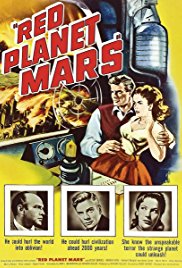
Then there is the script and direction. There are too many speeches about nothing much to slow things down and pad it out to feature length. Some of that may be down to the director who does not give pace a priority. There are bumps and drags. But the greatest problem remains. Before getting to that, some context.
The dumb blonde Peter Graves is a radio astronomer who has a home laboratory where his wife assists. He collaborates with Distinguished Professor who has a big telescope. There is much blah, blah, blah. The Prof has photographic evidence of the Schiaparelli canals on Mars and has observed how the polar ice cap is melted into the canals. (These canals were born of the fertile imagination of Giovanni Schiaparelli [1835-1910].) This is proof of intelligence at work! What other explanation could there be, Erich?
It fits because Blonde Peter is getting radio messages from Mars, sort of. He is sending to Mars and later he gets a reply that is identical to his message. It is not an echo, that has been checked and ruled out. So he says ‘tomato’ and later the reply comes ‘tomato.’ It is the way a child might repeat what a parent says to it. This conversation is so boring, Peter will never get another research grant unless he can move things along.
 Peter doing his dumb blonde routine.
Peter doing his dumb blonde routine.
Ah ha, an MIT graduate, Blondie decides to send the mathematical constant, pi. Why didn’t he think of this earlier? Well he is a dumb blonde. The Martians will recognise it and extend the result, and… Not only is this a mathematical constant, it evidently is a universal. Huh?
The Martians use the decimal system and Arabic numbers? Clever those redskins. Oh and Morse Code, too, since that is what Peter uses to send.
Worse the explanation of pi is inverted while it also asserted in this garbled dialogue that one cannot have, make, or use a wheel without knowing pi. Oh. Even the fraternity brothers snorted at that, during a brief moment of consciousness. A circle can be made with two sticks and piece of string. Stick a stake in the ground. Tie the string to the second stick and extend the string and walk about the perimeter. The footprints describe a circle. Voilà! A circle. Then there are round stones and logs, and….
Still this is a good set-up. It has basic credibility, an element of mystery, attractive leads. and the promise of more to come. The pace is good at the start; the cinematography is crisp. That is the first third of the run-time.
But wait, wifey goes all wifey. She is a zealot and fears all this science might disorder the Lord’s work. She goes on and on. Science destroys. Prayer is good. Though we never see her doing anything Christian, like shut up and do good works, give away some of the luxury furnishings in their home, teach their children to offer hospitality to visitors, or any of that boring stuff. Rather she fulminates. (Another case this is where the actor ought to have punched the lights out of the screen writers, John L. Balderston and Anthony Veiller.)
Still she wants to send truckloads of prayers to hurricane victims and not desalination planets, vaccines, or MRI machines, and trained up doctors. For this, by the way, she is much praised in the half-witted remarks on You Tube. So much for the longterm salutary effects of free public education.
Peter puts his Jim Bakker wife into her box, and continues talking to the Martians. Which one is the nutcase?
In a parallel plot the Russkies are also trying to dial up Mars. Red Planet Mars, right? It must be Red. (Get it, Mortimer?) No luck. Their vacuum tubes are leaky, just good enough to listen in on Peter’s transmissions. Some Russian is spoken though the chief villain is Michael Anthony, later of fame on television, who speaks only nasty.
The NBN connection to Mars clears and Peter get the skinny on Mars from his unnamed correspondent. Mars is Eden. There is no scarcity. No disease. Obama-care for all. No bad stuff at all. Not a single Republican on the planet. Everything is free. Everything is good. It is an all-over Donna Reed Show world. Average life span is three hundred years. (Think about sitting through strata meetings for three hundred, that is, 3 0 0, years while Mr. Numnuts bangs on about the drain pipes.) But not a word about those canals or the ice cap.
News of this paradise gets out and hits the spinning headlines around the world. Realisation that Mars is so well off depresses everyone on Earth in a kind of reverse of schadenfreude and they stop consuming, working, earning, start phoning in sick, altogether which makes the world economy crash and society begin to collapse.
How come the Martians are so well off, asks Blondie? Well, they follow the words of the Lord to the last detail. Yep the little green man from the Red Planet starts spouting the King James translation of the New Testament. No copyright?
This news heartens the god-fearing Westerners, and does-in the Earth Reds. The Soviet peoples rise up and overthrow the Commies. Bye, bye Michael Anthony. The Patriarch puts Vladimir Putin in the big chair and he in turn puts the Twit-in-chief in the Oval Office.
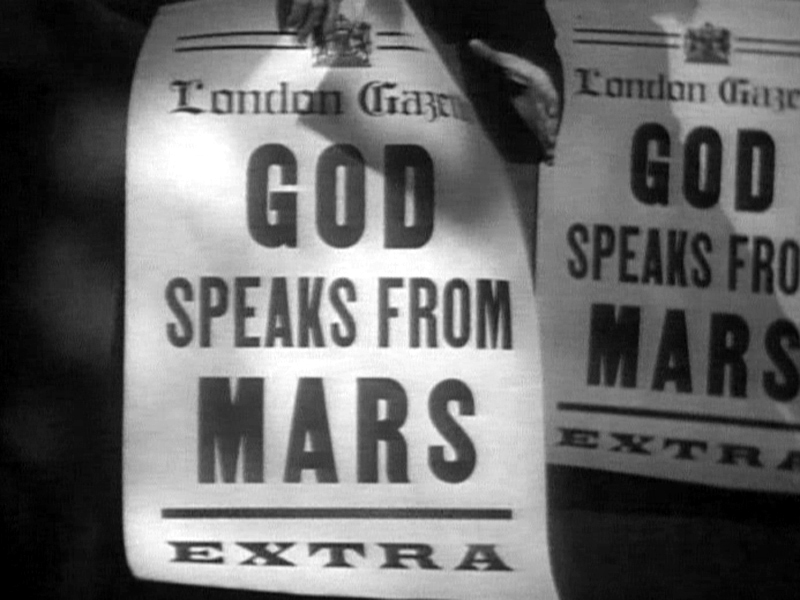
At this point the Hallelujah Chorus should have cut it, but there are few more twists and turns. They just do not know when to quit, these people. Fortunately, I do.
Why the good news about Mars should depress people and lead to social, economic, and political collapse in the West is anyone’s guess. Likewise, why this news should arouse the Soviet populace is another guess. After all, if they needed scientific evidence via that radio to uphold their faith, well then, it is not faith now is it?
All of this is presented with a straight face. God is a Martian! He is a Red from the Red Planet. See title. And like all Martians he is a little green man. Tricky as a Red could be, hiding behind that green look. Lyndon LaRouche is right the Green movement is Red at heart! Mars, the symbol of war and blood, is E D E N. Is there an NRA message in this? (Don’t know this Lyndon? Keep it that way.)
No wonder the half-wits commenting on You Tube love it. Still less, do any of them understand the liberation rhetoric of the King James edition of the New Testament, but they wax enthusiastic in the self-imposed dark.
Janne Wass says on the blog Scifist that the original stage play from a generation earlier used the religious card for laughs, but when the playwright tarted it up for the cinema in the frigid atmosphere of the Cold War, it went all serious, solemn, and sanctimonious, a cynical judgement of the audience in 1952 and one that continues to payoff. It is impossible to underestimate some things. It was during the Korean War and the HUAC rampage for those who were not born and have no brain.
‘The Wizard of Mars’ (1965)
From IMDB 3.4 / 359, 1 hour and 18 minutes
In far distant 1975 four astronauts are Mars-bound when they check in with Earth control. Everything is AOK. We knew that would not last. It didn’t. No sooner did Deep Voice hang up the phone, then strange things began to happen.
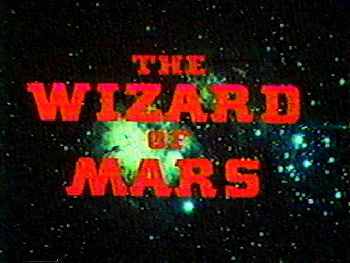
The plan had been to orbit Mars once, gathering data by scans, ogling, and pressing buttons, when the ship began to shutter and shake. Was it a meteor strike? Meteors are always on hand during space flight films. Was it some force from Mars? Had the lease expired on the ship? Was not it built by the low bidder?
The crew is four, along with Deep Voice, for whom this is the single credit in the IMDB, there is Goofy Charlie, Doc, and Whiner. The dialogue goes like this, repeatedly: ‘I dunno,’ Deep Voice. ‘Let’s find out,’ Goofy Charlie. ‘I’m scared,’ Whiney. ‘Let’s study it,’ Doc. This four-cornered exchange occurs enough times to send me to the crossword puzzle. Deep Voice never knows anything, making him the perfect McKinsey manager, having no encumbrance of knowledge. Charlie is always ready to leap into confusion. Doc wants more data before moving.
Whiney is the woman in the crew and she is always scared, when is not afraid, worried, sick, crying, or wailing. Personally I thought she should walk off the set and sock the script writer for sticking her with such a pathetic character. After all she sat on a mountain of combustible liquid rocket fuel to travel a squillion miles through the void of space to get there, and once there she goes all mushy. Really! ‘Sock him, girl,’ we cried!
More generally I considered the question of whether these four were the best the population of the Earth could find for this unique mission. A leader whose big line is ‘Dunno.’ Doc who looks like a Colombian drug lord. All that about study is just cover. Charlie the dolt. Really, this is the A-Team. Next thing a television clown will be US president.
Oh.
When things go wrong the crew has to land on Mars, though the ship, was not designed for that purpose and compromises have to be made. They use the command module as a heat shield and retreat to the landing pod. They jettison the module and bump, bump, bump, they land on Mars!
Doc wants to wait in the pod for rescue, estimated at four months. Whew, did he bring that much deodorant? (Well, it is a fair question.) Whiney also wants to sit tight and be scared, but Dunno Deep Voice wants to find the remains of the command module and salvage the radio and his PlayStation from it. Using the radio they can pinpoint their location (if by some miracle they can figure it out) and he can pass the time with the PlayStation. ‘Let’s,’ says Charlie, again, and again. My brief hope that they might jettison him went for naught.
Since he has a deep voice, the others agree with Dunno. They don their space suits, for once not those from ‘Destination Moon’ (1950) which must have disintegrated from repeated use under bright lights, and sally forth. Whiney goes on about water, food, nail polish, while silently cursing the script writer. Doc constantly falls behind studying sand, rock, paper, scissors, whatever. Charlie bounds around like a puppy off the leash. Whiney…. well,… Dunno still doesn’t.
For the next thirty minutes or more they traverse Mars. They are awed by it, fascinated by it, wary of it, and thrilled to be the first Earthlings to see it.

What a change of pace from Mars movies up to this time, when most Earthlings on Mars, just want to go home. Though ‘Rocketship X-M’ (1950) has some splendid imagery of a mysterious sepia toned Mars, none of the intrepid adventurers seem to notice, while in other films the explorers do no exploring whatever. In this respect, ‘The Wizard of Mars’ is superior in its effort to present Mars as unknown, mysterious, different, and so on.
The science may be whacky but at least it tries to present a brave new world.
That the only creature in the feature is a PVC alligator is down to the materials at hand. Though the creature high point has to be the Ferengi under glass with a transparent skull for a dome in the city they discover.
Yes, they discover a city by following, I am not making this up, a yellow brick road to the castle on a hill. The Wicked Witch was out but the Ferengi was in. (If you don’t know ‘Ferengi,’ get a life! Or ask The Google, as we were once advised to do.)
Regrettably the Ferengi with the glowing dome merely points the way, and bows out. Too bad because though he had been dead for eons, he showed more life than the Wizard to follow.
The Wizard is the head of John Carradine projected against a field of stars mouthing a ridiculous but lengthy speech about space (vast), time (long), and Visa card payments (overdue). He went on and on, and I began to pine for the thirty minute trek across the sands of Mars, which sands by the way, were white and not red, because it was filmed in Great Basin National Park in Nevada where red sand is scarce. Most of the time during this rant he is out of focus and that helps endure it.

Finally he comes to a point. (He must have been paid by the word, though pretty clearly this is one take and his contribution to the film is this ramble.) If these strangers (I’ll say) will just adjust the universal symbol of time, he will – Hey, presto! – power their rocket ship back to Earth. It seems his watch has stopped and he has forgotten how to set it. Just like my granny.
Charlie says, ‘Let’s.’ Deep Voice, ‘Dunno.’ ‘Let’s study it,’ Doc. And, inevitably, ‘My watch has stopped,’ Ms Whiney. (She really should have socked the writer. Though it should be noted she is not harassed by the men in the crew.) Turns out easy enough. The Universal Symbol of time is a pendulum. Remember that, class. Charlie adjusts it by replacing the rock crystal with the city within. Don’t ask.
Whuska! Off they go back on board the space ship, checking in with ground control for re-entry, only two minutes after their last check-in! Two minutes! What? Was it all a dream? The laundry suggests otherwise but these four are puzzled. Look at yourselves! Their clothes look lived in, torn, dirty, and rumpled. Moreover, and conclusively, wee Charlie has grown a dirty upper lip for Movember. The script writer and director have overlooked this obvious and visible evidence.
This opus has had other titles. including ‘Horrors of the Red Planet’ and ‘Alien Massacre.’ Neither is accurate but the marketing department prefers alternative facts. It has also been re-cut hither and thither to make a silk purse out of it. No go.
A word on John Carradine (1908-1988), the man who pursued a triple career. He appeared in many classic A-features like ‘Stagecoach’ (1939), ‘The Grapes of Wraith’ (1940), ‘The Last Hurrah’ (1958), ‘The Man who shot Liberty Valance’ (1962), ‘Cheyenne Autumn’ (1964), working with some of the greatest stars and directors in the Hollywood firmament. This is by no means a complete list.
In parallel he also was also a guest star in every television series of the epoch, ‘Gunsmoke.’ ‘Perry Mason, ‘Mr Ed,’ and so on and on and on. Though not, I noticed, in ‘My Favorite Martian.’
But by night he also appeared in such cinematographic works as ‘Captive Wild Women’ (1943), ‘Revenge of the Zombies’ (1943), ‘The Mummy’s Ghost’ (1944), ‘Half Human’ (1958), ‘Invasion of the Animal People’ (1959), ‘Curse of the Stone Hand’ (1964), ‘House of the Black Death’ (1965), ‘Blood of Ghastly Horror’(1967), ‘Vampire Hookers’ (1978), ‘Evil Spawn’ (1987), and ‘Buried Alive’ (1990), which fittingly appeared two years after his death and that was not his last credit for he died on set. This is by no means a complete list. It would seem, he never said ‘No’ to a part.
The script writer’s previous major work is listed as ‘Monsters Crash the Pajama Party,’ which was never produced. Sighs of gratitude were hears around the room at that news.
Perhaps it was best that the print I watched was smeared. Then again, perhaps, it was made that way. Per Wikipedia it was made using an optical printer for special effects and was filmed for $33,000. A glance at the cast and crew on IMDB suggests none of them had a prior or subsequent career in the dream factory. Still the space suits looked good, and the desert trudge was noteworthy, if boring.
‘Just imagine’ (1930)
The facts from the IMDB: 1 h 53 m and 5.5 from 507
A whopper from 1880, oh wait, make that 1930, but it opens with a comparison of New York City in 1880 with that of 1930 to illustrate the change in fifty years and then projects another fifty years into the future for the story of Romeo and Juliet in space suits, sort of, with singing and dancing. Yes it is that rarity of rarities, a Sy Fy musical, only the second I know of. (Read to the end to find out about the other, or just scroll there.)

In distant 1980 things have come, pace H. G. Wells. Evidently traffic is so bad that everyone uses a personal, fold-up light hover craft to get around. The craft is a light airplane capable of vertical take off and landing, and can hover, as the opening scene shows. In it Romeo and Juliet meet in the air and each sets their craft to hover, while they talk of their troubles.
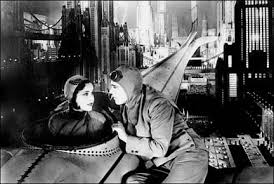
Troubles? Yes, they have troubles right there in Sky City.
For a start the Volstead Act is still in force, as one of the characters says in a contemporary reference. Fraternity brothers, cover your ears. Moving on.
Think of Plato’s marriage festivals first, to get in the right frame of mind, Mortimer. A man has applied to the Marriage Bureau to conjugate with Juliet against the application of Romeo, whom she prefers. In this world she is not even consulted in the matter. The Bureau decides in the favour of the other chap, whom we shall call OC. OC is of a higher status than Romeo and so gets the wife he wants. Period. End. Well, if it ended there, it would be not one hour and fifty-three minutes long.
Men apply to marry women, but women, as it explicitly stated, cannot apply to marry men. This process is asymmetrical.
Romeo appeals and has four months to lodge a counter application. But how can he raise his status in that time? He is already at the top of his profession as a Zeppelin pilot and there is no way up from there. (Get it, Mortimer? [Probably not]) Not sure why but he does not think of going into management. Guess the scriptwriters did not foresee the Invasion of McKinsey Managers and the havoc their KPIs can bring.
He wanders around the Big Apple and bumps into Igor to whom he tells his troubles. This is just the man Igor is looking for, because he boss, Mad Emeritus Professor 1, wants a disconsolate but experiences Zeppelin pilot to fly his experimental, virginal spacecraft to Mars. To be the first man to fly to Mars and return will give Romeo a super deluxe status and he will easily win Juliet’s hand and all that goes with it. If he survives the trip.
Earlier when he was drowning his sorrows with this buddies, they went to watch, as one does, Mad Emeritus Professor 2, resuscitate a dead man killed in 1930.
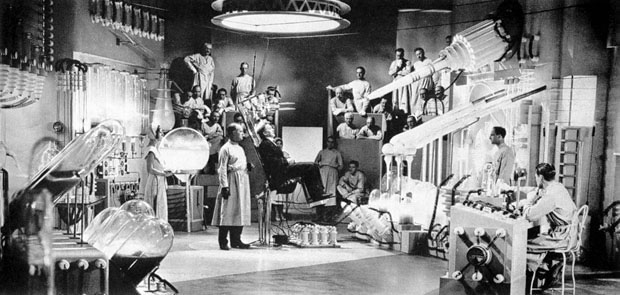
He is the Comic Relief, whom we shall call Lazarus. Lazzie tells stupid jokes for the rest of movie. Reviews from 1930 suggest this was instantly detected.
Naming the characters at will is both easy and necessary because in 1980 no one has names but only numbers, e.g. JN-102.
Romeo, one of his drunk buddies, and Lazzie fly to Mars. Gaavoom! And their iSpaceShip hits Mars. There they are greeted by Busby Berkley’s dance company and have a high-ho time.
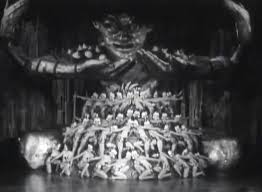
Though things are confusing because everyone on Mars is a twin, one good and the other a Republican. They get confused. They do look alike.
Every now and then someone breaks into song, and there are many dance numbers. Indeed the Martians are mimes who express themselves in dance, a lot.
The film was enormously expensive to make with all those sets, mechanical contrivances, travelling mattes, and extras, and it bankrupted the studio just as the Great Depression closed theatres. Not a CGI in sight. It was made prior to the Hayes Code and there is much female flesh on display, and some implicit homosexuality. On the other hand, there is little cigarette smoking, which is so pronounced in some other, later Sy Fy films on the Moon and Mars and even in the space ship en route.
In 1930 talking pictures were in the first decade and many of the conventions, camera angles, transition cards, and the like are used. In vaudeville shows there was often a comic or clown on the stage between acts, as one set of performers cleared out and another set up, to fill the gap and hold the audience. That is what Lazzie does here, though in this case he had the reverse effect of clearing the sofa for a time, with his lame, forced, often incomprehensible efforts at humour. Suddenly an urgent need came over this viewer to fill the dishwasher.
Maureen O’Sullivan is in it, before she landed in the jungle with Tarzan, but like most of the other players, she goes through the motions. Marjorie White as her brassy girlfriend is the only one who injects energy and vitality, albeit not creditability, into the proceedings in her scant screen time. The word ‘scant’ also refers to some of her costume, what there is of it.
Among the other appurtenances of 1980 are video phones and televisions, and meals in pills. Buildings with two hundred stories are equipped with light-speed elevators.
Among the songs in this film are ‘Old-Fashioned Girl,’ ‘I’m Only the Words, You Are the Melody,’ ‘The Drinking Song’ and ‘Never Swat the Fly.’ ‘The Drinking Song’ is staged on a dirigible and the ‘Never Swat a Fly’ was a show stopper when, instead of Fast Forward, mistakenly I pressed Pause.
Before condescension overtakes us, pause to consider how well we might do today just imagining 2067? About as well as John Lennon did?
Fritz Lang’s monumental ‘Metropolis’ (1927) had only appeared a couple of years earlier, and many in the audience for ‘Just Imagine’ may have been unaware of it. The ‘New York Times’ reviewer, at any rate, does not mention it. Mortimer, that was a silent movie with a wall of sound for orchestral accompaniment.
‘Time Flies’ (1944) is the only other entry in the category Science Fiction, Musical, Comedy. Believe it or not, it was made in England. In it four contemporaries travel backward in time to the Sixteenth Century to correct Shakespeare’s spelling. Well, what other explanation could there be, Erich?
‘It! The Terror from Beyond Space’ (1958)
From the IMDB: I hr 9 m with 6.1 / 3674.
A creature feature concerning a Mars mission. Here is the set-up. In distant 1973 square-jawed Marshall Thompson is the man-in-charge, but, well, on Mars things happen – off camera. His whole crew of nine has been killed and only he survived to be rescued by a second mission. Marshall is suspected of murdering his crew, since what other explanation could there be, Erich? Marshall does not know what happened. Napping while in command it seems. Even if he did not kill them, and no motive is ever mentioned, he is guilty of malfeasance.
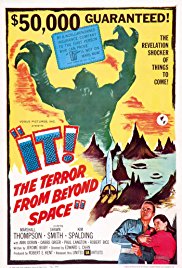
But on the way back in the rescue ship…., yes, down in cargo hold is a very ugly and very large set of bunions. Any one with feet like that is going to be irritable. But what podiatrist would take on such an impossible set of toenails? For convenience let’s give this creature a name, something creative and imaginative: Mars Bar (MB). Where was TSA when this piece of work boarded?
MB sets about murdering the crew of the ship on the return flight while Marshall is locked up, so he is off the hook. No effort is made either to communicate or contain MB, instead the crew, mid-flight through space, get out their war-surplus pistols, rifles, bazookas, and hand grenades which they use with the panache of Hollywood, shooting from the hip. None this blasting bothers MB much, nor does it rupture the ship’s skin. They must have build it it for inside battle. Me, I would have aimed at the toes.
Murdering members of this crew is almost too easy. They repeat their mistakes repeatedly. They open hatches to see what is going on and the opener finds out the hard way. That does not discourage his mates from doing the same thing again, and again…. Until there were (just about) none.
MB stowed away on Mars for reasons unknown, and so comes from a particular place. How that could be ‘beyond space’ as per the title is lost on me.
Spoiler Alert. When all else fails the remaining crew don the well-used space suits originally made for ‘Destination Moon’ (1950) and seen in many films since, including this one, and let the oxygen out and this kills the creature. Quite how the surveyors are going to re-inflate the ship and return home is elided. That the creature needs oxygen is … just said since he parades around in the rubber buff.
Also lost on me was the skull with a bullet hole in the forehead which is produced by one point to prove Marshall’s guilt. No explanation is offered then or later that I heard, but napping I may have been. Yet at no time did MB pack a rod. With feet that like he had no need of a gat.
There is nothing about Mars, though two ships have landed on it. Both were clearly and exclusively American. There are two women in the crew who by turns serve coffee and scream. On the other hand the writers were confident enough in the audience to include an airlock without and explanation and also to a multi-story ship again without stopping to explain it. That is some evidence that the genre was maturing.
The end is the tag line that ‘Mars is death!’ No more missions will go to Mars. Instead the strange creatures called Republicans will be examined.
Still this experience did not deter him from ‘First Man into Space’ (1959) where things were even worse.
Marshall Thompson geared his whole life, it seems, for Hollywood stardom, or so it is said. His family moved to Los Angeles to give him a shot while he was but a boy. He grew into a handsome young man and did all the right things and in 1944 and 1945 when many other Hollywood stars were involved in war work of one kind or another, from active service to fund raising or propaganda filming, he got some parts, but thereafter ‘It! The Terror from Beyond Space’ is what he is best know for. Except for…
 Marshall Thompson was so named because his family claimed relation to the first chief justice of the U.S. Supreme Court, John Marshall.
Marshall Thompson was so named because his family claimed relation to the first chief justice of the U.S. Supreme Court, John Marshall.
Yes, ‘Daktari’ in the late 1960s. By some twist of fate he got cast as the veterinarian in an African game reserve and made a success of it. Moreover, even when it wound down, Thompson found he could not let it go and thereafter worked as a philanthropist to raise money for African animals the rest of his days. Though he was upstaged in ‘Dakar’ by chimpanzees and lions, he forgave them and became a friend to they and their kind.
‘Murder in Space’ (1985)
A Whodunnit on an international space mission made in Canada for television with a major cast including Michael Ironside, Wilford Brimley, Martin Balsam, and more. The Conestoga has a crew of nine: two Soviets, two American, one Canadian, Italian, French, England, and East German. This crew has just completed the first Mars landing and exploration and are returning to Earth, a few days from re-entry when things start happening.
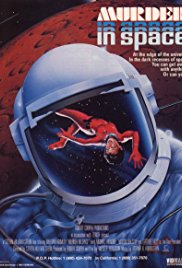 The graphic is misleading as there is never a cadaver floating around and no one wears a space suit.
The graphic is misleading as there is never a cadaver floating around and no one wears a space suit.
Contrary to the IMDB summary, the start is the unexpected and unexplained death of a Soviet woman on board, about thirty years old. That engages the attention of ground control in the form of Wilford Brimley. Fearing a Martian pathogen is on board, the ship is ordered to hold position for further analysis. There follows a long distance autopsy using the facilities of the ship and analysed at ground control. This is one the many interesting ideas in the film that are not developed.
The IMDB data is 4.7 / 160.
There are political repercussions to consider and the Soviet ambassador is Martin Balsam who intrudes, ever so tactfully into the proceedings along with Arthur Hiller as the US Vice President in charge of the space program. The more so when the autopsy reveals that the Olga, the victim, was suffocated.
Murder! In Space! That is bad. It redoubles the reason to delay landing. There is worse. Another one of the nine little indians snuffs it due to cyanide poisoning. Yikes! Is this homicidal cabin fever when so close to home, or what? Or what?
Spoiler follows. There follows a convoluted Agatha Christie like unraveling. The East German killed her because she threatened to reveal his homosexuality. Before she died Olga put cyanide in the insulin of the poison victim who refused to help her. Ironside killed the East German in his self-appointed role of judge, jury, and executioner because he figured out he had killed the Soviet. The second Soviet accidentally blows himself up – this is the explosion mentioned on the IMDB — when he responds to a coded order to seize control of the ship.
Qualifications are in order. First as to the explosion. It was not clear to me, and yes I was paying attention, whether the explosion was triggered by accident or it was booby trap to silence the Soviet planted by the Soviet government. While he was fumbling with the gear someone was knocking on his door and that distracted him. Despite the fact that the explosion fatally ruptured the ship, the door knocker walked away. More on the fate of the ship and surviving crew below.
Second, Ironside kills the East German because no one has jurisdiction in space and he would otherwise go free on landing. Really! I would have thought the Soviets would deal with him. Jurisdiction is much discussed but not developed in plot or intellect. It caught my attention because we used space jurisdiction in debate in college. The details have long since been overwritten.
The TSA was not on the job for this flight. Olga had a supply of cyanide for recreational use and the Soviet man had a sub-machine gun in his NRA-tagged luggage.
There is nothing about Mars, the mission, or space flight in the movie. Our nine might well have been on a railway train, a ship at sea, a castle on a hilltop, or cut-off by the weather in Otranto Inn. That was a major disappointment. After the ship is damaged by the explosion, despite the earlier worries about either a pathogen or a killer on the loose, the remaining crew members exit via an escape pod and land.
Likewise I never understood why the US Vice President had the call on an international space mission to Mars. In general I thought the political dimension was well handled, though a needless plot twist was inserted when the Soviet premier changes mid-flight. That is linked to Olga, the first victim, but it seemed a needless distraction. Although none of the other nations figures in the diplomacy.
The Wikipedia entry says the film was made without an ending, and only after some focus group screening, was the explanatory end filmed. Groan. That tells me that no one knew what they were doing or why. It shows.
On the plus side there are women in the crew and there is sex but the women are portrayed as capable crew members with jobs to do and they do them, only once is one of them required to go all female and scream, this from someone with the grit to walk on Mars. But otherwise the film has left behind the puzzle of how a woman could be a scientist that bothered so many men in earlier Sy Fy. A small mercy.
The pressure of the media feeding frenzy is well realised, but rather subdued compared to the reality. But the constant demands by representatives of the media distracts and confuses everyone.
The direction is crisp and the actors are fine. The cinematography is fluid. Ironside was effective as the man in charge who never expected this!
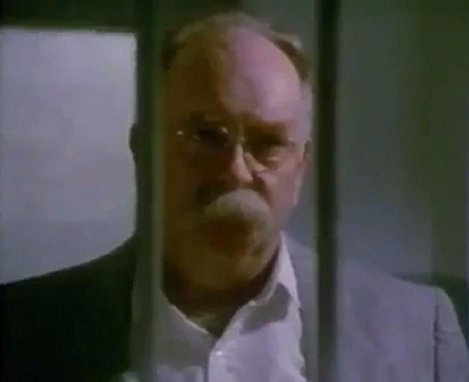
Brimley is always a treat.
‘The Invisible Man’s Revenge’ (1944)
The last of the Universal franchise of TIM (The Invisible Man) before descend to Abbott and Costello. The credits declare this to be an original screenplay, and the ubiquitous Kurt Siodmak is himself invisible. The story lines from ‘The Invisible Man’ and ‘The Return of the Invisible Man’ have atrophied.
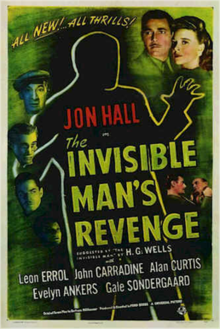
In this outing the invisibility is born of John Carradine, squinting to prove his intellectual credentials, who experiments on birds, cats, and dogs until Jon Hall comes to the door. This is Hall’s second tour on invisibility duty. When last unseen he was saving the USA from a Nasty invasion, when not lecturing on the American Way.
Instead of another mission as a secret agent, Hall is now a homicidal maniac who has escaped from the White House, oops, from an asylum in South Africa. The film opens with him cutting his way out of Qantas class… from Durban on the docks of Southampton. He seems to have surrendered his Yankee citizenship, too, become Hollywood Brit.
He has come to England for revenge on Spider Woman and her insipid husband whom he claims earlier cheated him out of a diamond mine Africa.
 Spider Woman
Spider Woman
Spider Woman is no one to trust, but it seems she and her husband did not cheat him or leave him for dead after clubbing him, though he alleges all of this. Reality does not matter to him, in the spirit of the Tea Party, for Hall thinking it is so makes it so and he sets out to bedevil them. After efforts to placate him fail, they put the local plod onto him and he absconds, stumbling to Carradine;s door.
Carradine is ready for a human subject, and here he is! One jab and there he isn’t, now invisible. Special effects follow, one being a darts game in a pub. Oh hum. Then floating glasses and such. The magic, however, has worn off for this viewer.
The twist here is that Hall wants to be invisible to elude the plod but visible at other times to assume a new identity, and to make that transition between the two states he needs blood, and lots of it. Several home-brew transfusions follow, and Carradine pales to dry. Much to’ing and fro’ing follows, all without eliciting much interest. This sanguinary element references the conclusion of ‘The Return of the Invisible Man.’ Hall’s megalomania is also of a piece with the foundation stone, ‘The Invisible Man’ (1933).
In the end Brutus kills him. The end. Brutus? Carradine’s loyal and once-invisible dog which has dogged his steps since the death of Carradine. We cheered Brutus on. At 1 hour and 18 minutes we only wished Brutus had got him earlier.
This outing has shifted genres to Horror and left Sy Fy. This villain is a competitor with Bela Lugosi for blood. One imagines, and if I can imagine it, surely some hack did, too, Dracula and TIM fighting it out in a Red Cross blood bank, like two oenological connoisseurs in a cellar of fine wines. Crash and smash! This idea is copyrighted but for sale, cheap. Contact the agent, if he can be seen.
In sum, TIM has gone back to his origins in England and there are no references to the war, though this was made in Hollywood in 1944. No doubt the assumption was that audience had enough of war entertainment, as the casualty lists grew.
Spider Woman, Edith Holm (Gale) Sondergaard (1899–1985), won an Oscar in 1936 and was nominated again in 1946. She quit films in 1949 and left Hollywood when her husband, Herbert Biberman, was pilloried by HUAC and she only reappeared on film in 1969. Our loss. In the interim she trod the boards in New York City.
‘Invisible Agent’ (1942)
More shenanigans from an invisible man with a screenplay by Curtis Siodmak, also known as Curt and Kurt. In 1942 the more Anglo-Saxon name Curtis appeared in the credits. And this title is very much a wartime period piece.
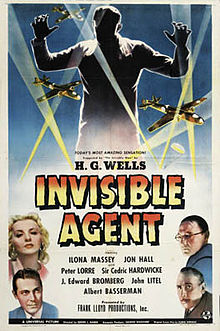 Lobby card.
Lobby card.
From get-go our hero, Jon Hall, is accosted in Nowheresville USA by thugs led by the ever so British Cedric Hardwicke, all dressed in mufti, and Hall knows instantly that they Nasty Germans. Cannot fool a Yank in 1942. Hardwicke knows invisibility when he sees it since he saw it in ‘The Return of the Invisible Man’ (1940) in which he led the bill. Since the invisible man punched his lights out in that film he became a Nasty and is out for celluloid revenge.
In this series the name of the invisibles has varied, Griffin, Radcliffe, Nerks. Is such confusion the inevitable result of invisibility, ahem, because maybe the lady did not know which was whose. That is the conclusion of the fraternity brothers.
The Nasties are Naziis. They want the formula for invisibility or else…. Hardwick is a bloodless reptile, but the scene belongs to the understated Peter Lorre as a malevolent Japanese along for the fun. Hall is a printer and in his printshop is a guillotine paper cutter. Shiver! Lorre thinks of ways to use it, on Hall.
The Nasties are overmatched, four thugs and a Nip against one Yank on his home court. He fights them off and they scurry away.
That Japanese is Mr Kentaro Moto who has answered the call to the flag and is now working for Japan and not the International Police. Yikes. He is perfectly sinister but he was useless in the fight. Strange how he had forgotten all that judo.
Hall is then asked ever so politely, not a waterboard in sight, to give his formula to the USA government, but he gets all pompous and refuses because it is too terrible a secret to reveal. In earlier films the serum was dangerous to the recipient because of its side effect (megalomania, aka Potomac Fever) but that is largely omitted here. The terror is in the capacity to be invisible and the evil that invisible evil men would wrought. As already seen the invisible woman was resistant to Potomac Fever.
Then the spinning newspapers report Pearl Harbor, and remembering Moto from the printshop disturbance, Hall goes to a Big Committee meeting in D.C. Who these men are is never explained, and some speak with European accents and some look more oriental than Moto ever did, amid the many Midwestern American accents at the table. Hall offers the formula, and speeches of gratitude are heard, but he has a caveat. Oh?
Only he can be inoculated, and he must do it himself, with the drug because…. Is it the side effects? Is it the secret which might fall into the wrong hands? Not clear to this viewer.
Now as a weapon in war, what good is an invisible man, naked, barefoot, and unarmed? Would invisibility have helped the Finns in the Winter War? This question is never pursued, we just segue to the secret agent, the spy, the invisible agent spy: bare of foot, naked of clothes, and without a weapon in sight.
It seems the Nasties are planning to invade the USA, and the question is when is Invasion Day. Kind of reverse of D-Day in Normandy. They will launch this attack from Nasty HQ in Berlin! Amazing logistics will be needed for that in 1942 This practical matter is later brushed off with a throw-away reference to a suicide bombing fleet leading the way (for the U-Boats laying a bridge across the Atlantic).
Hall is parachuted into Berlin to find the date. Yes, Berlin, well Potsdam a few klicks from Berlin,though conveniently the road signs are in miles. At headquarters the Nasties are Abbott and Costello.
Mind, while parachuting down, Hall strips off his flight gear and that is a marvellous effect. He is invisible when he lands and the Nasties run around crashing into each other. Hereafter the invisible man, while remaining invisible, draws a great deal of attention to himself. The fraternity brothers recognised a kindred spirit in this ghostly presence.
Since he had no training, it seems also that he has no sense. He all but tweaks the noses of Nasties, leaves a trail even Abbott and Costello could follow, and generally makes it known that there is an invisible agent at work.
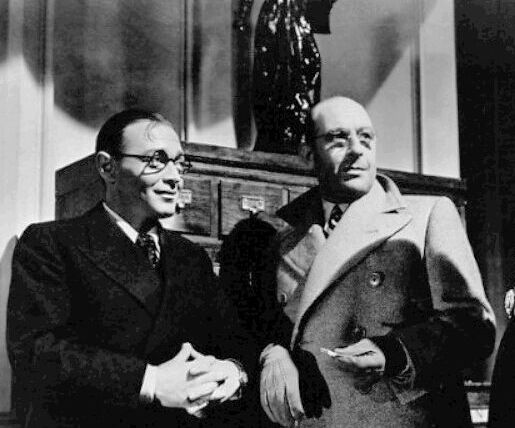 Moto and Hardwick get the word and converge on him, setting a trap, one even Homer Simpson would have detected, but not this ingenue who blunders in and when apprehended blames everyone else!
Moto and Hardwick get the word and converge on him, setting a trap, one even Homer Simpson would have detected, but not this ingenue who blunders in and when apprehended blames everyone else!
Not to worry, the Nasties even in Berlin are overmatched and Hall has little trouble in breaking jail, getting the exact date of the invasion, himself bombing Berlin for good measure, and flying off. Whew!
The special effects of invisibility are good. Here he is as a spectral presence which is far more eerie than complete invisibility though he is usually the latter.
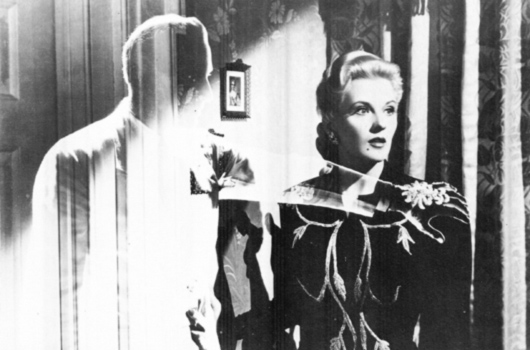
In addition to the parachute drop, our invisible hero takes a bath and as he soaps himself the lathered parts of his body appear, mainly his leg, an echo of the stocking scene in ‘The Invisible Woman’ (1940). Earlier there was a scene of his footprints in straw of barn, an echo of a scene in the original ‘The invisible Man’ (1933). Food, drink, telephones float in the air.
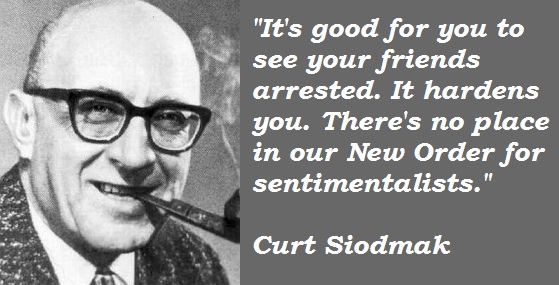
K(c)urt(is) Siodmak with a line from this movie
It was 1942 and Hall gives lectures time and again on the American way. If all of that was so important maybe he should been more responsible in concealing himself. The propaganda was dished by writer Siodmak, born a Polish Jew, and no doubt heartfelt since he had fled Hitter’s Germany a decade before finding his way to Hollywood, but it is also leaden and seems out of sync with the Abbott and Costello hijinks our hero gets up to when not at the podium.
‘Conquest of Space’ (1955)
George Pal produced this title and he always tried to get the science right, and left the screen play and direction to others in a division of labor, but, of course, he selected and hired the director and writer.
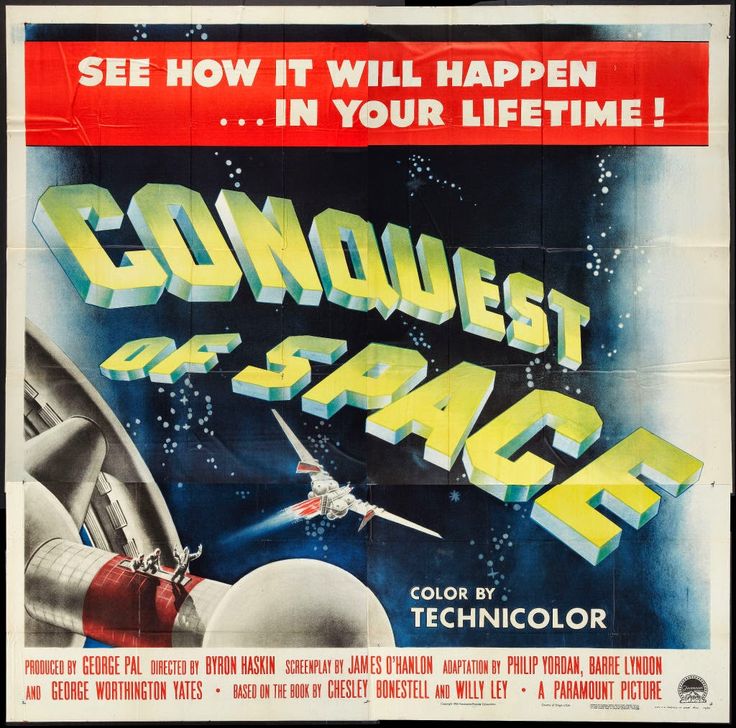
In this case he hired a director who specialised in special effects and knew nothing about directing a drama and a writer, well that is the problem, not one writer but several writers each of whom stitched in this and that and evidently no with a whole perspective. One output of the rumour mill has it that the studio executive in charge of production concluded during filming that the story lacked drama and insisted on adding the Oedipal element half-way through, while cutting the budget, a McKinsey manager avant le mot.
Pal’s groundbreaking ’Destination Moon’ (1950) had many critics who found it more like a boring documentary than a dramatic film. They said
it lacked humour
it lacked tension
it lacked sex appeal
it lacked humanity
it had too much science
it was too expository
it had too much vastness of space
and so on.
Pal went with the flow(s) and this is the result. All those elements ostensibly lacking in ‘Destination Moon’ were shoe-horned into the film. It is easy to picture the Happy Hungarian, as Pal was known, with a clipboard checking all these elements off the production schedule. The result is a mishmash of checklist items.
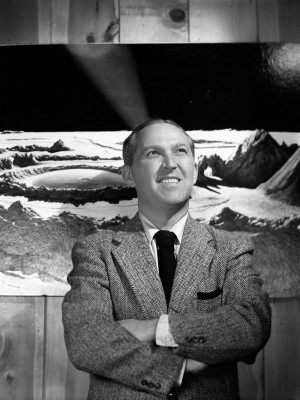
In a giant space station, the inevitable wheel because scientist at the time thought it was the way to the stars, a superior elite of the world’s best are preparing for the first moon landing. These individuals are the best of the best of the best of the best, a reference to the Men in Black for the cognoscenti. Each man is a volunteer, each man, for there are no women on the wheel, but yet there is still sex appeal. Intrigued? Read on.
That is the set-up and the ride is downhill from there. The writers reanimate the conventions of World War II submarine movies, where all the men were draftees, few were trained in more than turning a wrench, and the captain had sailed yachts. These superior spacemen complain about everything, want to go home, and are all Americans, almost. If this crew is the best Earth can do, better to stay at home.
Amid the crew are two foreigners, a Japanese and an Austrian. The Japanese gets one speech where he goes on about chopsticks as the miserable future for mankind, while the Austrian’s big scene is as hard to describe as it is to watch. Suffice it to say here it is pure kitsch.
The humour is supplied by an uneducated engineer who cracks jokes, I think, at intervals. Check. By the way this is a reprise for ‘Destination Moon’ where the radio operator did that.
The humanity must be all the whingeing by members of this superior elite who just want to go home. They are just regular guys, not super spacemen. Indeed.
The tension is maxed between commanding officer father and subordinate son, as if this is any way to run a railroad. Though there is a similar paternity in ‘Riders to the Stars’ (1954) from the typewriter keys of the ubiquitous Curt Siodmak.
The scientific exposition remains though, interspersed with lame jokes from the lame joker. Yes, these supermen in space still do not know the basics. All that training, all the preparation, all that work in building the space station wheel which was emphasised at the outset and gravity is still unknown.
‘The sex appeal?’ I hear the fraternity brothers asking. In another parody of World War II tropes the crew of the space wheel watches a movie with dancing girls and an uncredited Rosemary Clooney singing about love in the sand, an excerpt from ‘Here Come the Girls’ (1953). Sex appeal? Rosemary Clooney?
When that excerpt mercifully ends there are excruciating video messages for some crewmen. The Joker’s girlfriend drips 1950s celluloid sex on the screen, and then that Austrian, remember him, Ross Martin (who was born in Poland), who seems to combine German, Austrian, and Jew in a stereotype. His mother sounds like something from a Yiddish burlesque. Poor Ross. More humanity. Her private message to her son is screened in the recreation hall in front of the whole crew. Sensitive New Age management there.
The special effects are well done though many are borrowed from other films. But the vastness of space is there, and the movement from the wheel to the rocket and back is nicely done on a sled. And there is one memorable scene when the body of Ross Martin. who got in the way of an old reliable meteor, is consigned to the stars, though again the procedure mimics burial at sea.
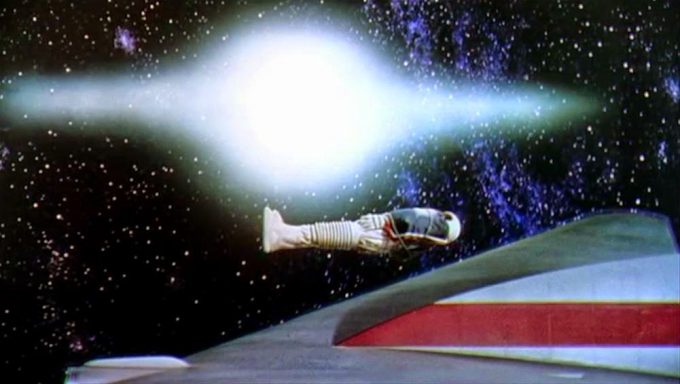
Who had to tell his mother? I wondered.
As Launch Hour nears, the impossibly handsome William Hopper, before Perry Mason took him on, appears to tell the elite team that their mission is not the Moon but MARS! Gasp! Groan! More whingeing follows from the supermen volunteers.
Walter Brooke as the general is top-billed, a journeyman television supporting actor. Who knows why Paramount with its stable of talents chose him is anyone’s guess. He seems flat and robotic, in what I suppose the director thought was military discipline. There is a subplot about space fever that comes from being in space too long or maybe from watching this film.
Since the mission has crept to Mars, the general asked for volunteers and some of the whiners volunteer so they can whinge some more, and a small crew sets off for the Red Planet. As they do the general gets religion from out of the black and blue of space. He goes bonkers and tries to scuttle the rocket ship and kill them all. Wow! Eric Fleming, before heading them up and moving them out on ‘Rawhide’ is his son and socks him. This sock saves their lives but infuriates one of the crewmen whose unexplained loyalty to the general is so great that seemingly he would rather be killed by him than see the general’s son sock him on the chops.
Even though the general has gone Tea Party feral, the son leaves him at large, while they land on the Red Planet, which looks like the red hills of Georgia. These space explorers show no interest in Mars and wait for the opportunity to leave. The general continues to gum up the works, until…. Remember Oedipus.
The Japanese plants a seed and it grows.
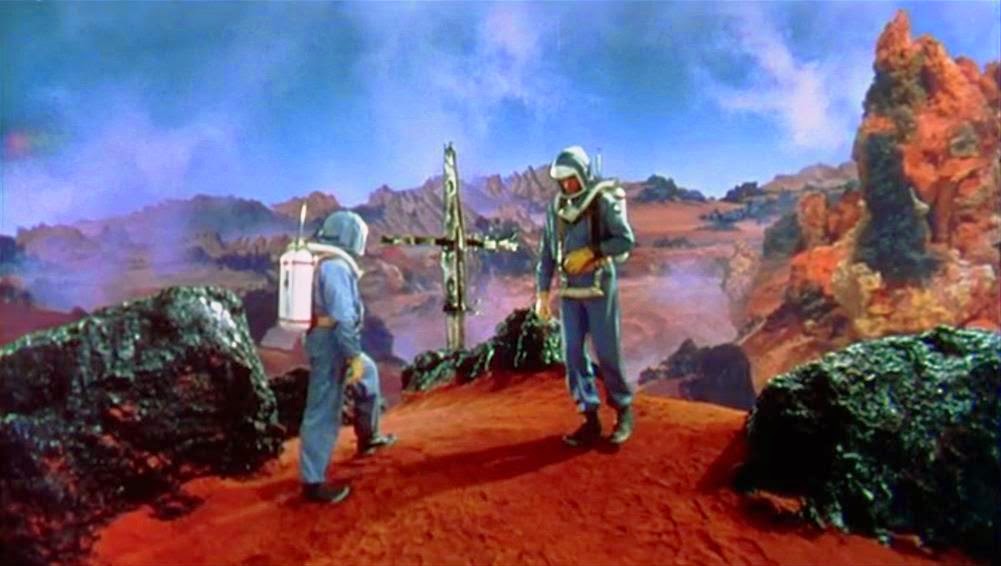
See, Georgia. Trite as it is on screen there is an important point which we would recognise today but which was missed both by the scriptwriters and the audience at the time, namely that we Earthlings are destroying our own planet and the mission to Mars is to find new resources, including food. It turns out the earlier speech about chopsticks had a point in its garbled nonsense.
They have to wait on Mars for the next launch window, though nothing about that is explained, though gravity had to be explained earlier, and thanks to the general their supplies are low. They make no effort to record observations or explore the red planet. However, it snows and with the water from that they can power the rocket back home! Well that is what it looks like.
But the snow is for Christmas and we have another derivation from WWII movies, with a schmaltzy Christmas on the front line. All the while the loyal crewman mutters threats to the son. It is all so stagey that no one is interested. least of all this observer.
Eric Fleming had a career on television which was cut short, when he drowned in an accident while filming on location.
This film concentrates on the psychological aspects of life in space, and not the technology, nor hairy and scary aliens. That is a welcome focus but the execution is so diluted that most viewers will miss the point. It is diluted mainly by all the tropes from World War II movies, the static direction, the wooden acting, and the mechanistic checklist. Moreover, there is little interest shown in space and exploration by this crew who just want to go home.
One famous scene is the dining hall. Yes, there is a dining hall per all those World War II movies, but in this hall there is no food, but only pills. Yet there is still a vast hall with cafeteria tables and the whole crew assembled for the service of pills. Another pointless trope that undermines the awe and mystery of space travel.
